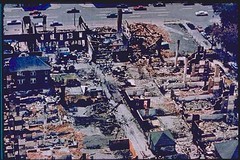
Photograph of the Linwood area destroyed by fire during the first day of the July 1967 rebellion in Detroit.
Originally uploaded by Pan-African News Wire File Photos
By STEPHEN OHLEMACHER,AP
Posted: 2007-06-28 02:31:03
Filed Under: Nation
WASHINGTON (June 28) - Phoenix has overtaken Philadelphia as the nation's fifth largest city, underscoring decades of population losses in America's big industrial centers.
Dan Loh, AP Estimates released by the Census Bureau shows that some of the nation's largest cities have lost huge parts of their population in the past half-century. Philadelphia, for example, lost nearly a third of its residents.
The nation's population has nearly doubled since 1950 - adding about 150 million people. But of the 20 largest cities at mid-century, all but four have shrunk, some by a lot.
Detroit, Cleveland, Pittsburgh, St. Louis and Buffalo, N.Y., have all lost more than half their population in the past half-century.
Philadelphia lost nearly a third of its residents, slipping to about 1.4 million people in 2006, according to estimates being released Thursday by the Census Bureau.
Like many big cities in the Northeast and Midwest, Philadelphia has suffered through a decline in the nation's manufacturing economy. City officials, however, have vowed to rebound.
"Philadelphia is not going to disappear," said Gary Jastrzab, deputy executive director of the city planning commission. "We have a good quality of life here. We have major universities, major health facilities and a very active pharmaceutical industry."
The Census Bureau is releasing 2006 population estimates for U.S. cities on Thursday. The Associated Press compared those estimates with population totals from the 1950 census.
Phoenix was barely in the top 100 cities in 1950 - it ranked 99th, with about 107,000 people. Last year, it had 1.5 million.
Phoenix added 43,000 people from 2005 to 2006, more than any other city, according to the Census Bureau estimates. It was followed by San Antonio; Fort Worth, Texas; Houston; and North Las Vegas, Nev.
New Orleans, which is still struggling to rebuild following Hurricane Katrina, lost the most people, about 228,000. The Census Bureau estimated the city's population at 223,400 in 2006, a little less than half its size before the storm.
Americans have been migrating south and west for decades in search of better job opportunities and warmer climates. They have also been moving to the suburbs and beyond, in search of bigger yards and houses, lower crime rates and better schools.
In 1950, nearly a fifth of the population lived in the nation's 20 largest cities. In 2006, it was about one in 10.
Many older cities are trying to reinvent themselves, relying on the universities, health centers and cultural attractions that have long been desirable, said William Frey, a demographer at the Brookings Institution, a Washington think tank.
"It used to be that the city was the whole regional economy. Now, it is just the center," Frey said. "These cities certainly can be viable with smaller populations."
Mark S. Schweiker, president of the Greater Philadelphia Chamber of Commerce, said regional economic conditions are a better measure of success than conditions in individual cities.
"We remain a significant economic force, and the census doesn't change that," Schweiker said. "The reality is we are situated nicely between the financial capital of the world in New York and the political capital in D.C."
Richard Vedder, an economics professor at Ohio University, sounded a note of optimism for the future of big cities, albeit a muted one.
"I think they've lost about all the manufacturing they can lose," Vedder said. "There's not a lot left."
No comments:
Post a Comment